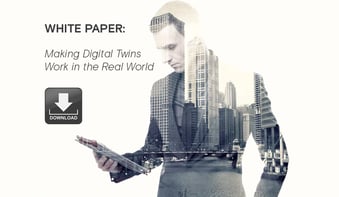Digital twins have matured significantly in the past several years, making them well suited for use in organizations and built environments. In fact, they’ve opened up incredible opportunities for solving big challenges in various built environments, like in commercial real estate buildings, hospitals, and smart cities.
Before we get to the problems digital twins can solve, let’s first review how digital twins have evolved over the years.
What is a Digital Twin?
At its simplest, a digital twin is a virtual replica of a physical product, process, or system.
A digital twin acts as a bridge between the digital and physical worlds, using connected sensors and IoT devices to collect real-time data about physical items. This data is then processed and used to understand, analyze, manipulate, and optimize the item.
The Rise of “Digital Twins of Organizations (DTOs)”
Digital twins have been traditionally used for single assets, such as wind turbines or jet engines.
In recent years, however, digital twins have become more complex -- connecting not just one asset, but rather systems of assets or even entire organizations.
This expansion means digital twins can now be used for a wider variety of use cases. By bringing together multiple assets and combining them with information about processes and people, their ability to help solve complex problems has been fundamentally expanded.
What has this meant for adoption rates? Well, research by Gartner in 2018 found that 48% of organizations that use IoT also use digital twins. Moreover, 50% of large manufacturers will have at least one digital twin initiative launched by 2020, and the number of organizations using digital twins will triple by 2022.

What Problems Can Digital Twins Solve in Buildings?
As a leader in the CRE industry, do any of these statements sound familiar?
- “Our operational efficiency has plateaued.”
- “Our operators lack full visibility and control.”
- “Our occupants aren’t satisfied with their space.”
- “Our competitive moat is narrowing.”
- “We lack the ability to predict and preempt events.”
If so, you’re not alone. These are some of the challenges that buildings everywhere are facing today, especially as CRE business models change, occupants expect more, and operating costs climb.
When you’re up against these challenges, a digital twin can help transform all aspects of your operations.
In fact, digital twins can be used to improve efficiencies, optimize processes, detect problems before they occur, and innovate for the future.
By providing a contextual model of your building and operations, digital twins offer:
- transformative spatial awareness;
- analyses of root causes;
- intelligent recommendations;
- the ability to self-tune; and
- the insight needed for predictive maintenance.
Digital twins give you clarity on the past, present, and future performance of your building, along with recommendations on how to improve outcomes. By bringing together data from your IT and OT systems, IoT sensors, and third party data in a contextual representation of your built environment, digital twins go well beyond a mere digital mock-up of the physical environment. Instead, they allow you to analyze data, workflows, and human behaviours in your portfolio, in real-time, letting you take immediate action to optimize performance or conditions and improve the future state of your buildings.
The result? Digital twins offer truly remarkable outcomes for the built environment.
Want to learn more? Check out our Digital Twin E-Book today!





